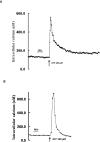Terbutaline, forskolin and cAMP reduce secretion of aqueous humour in the isolated bovine eye
- PMID: 33347508
- PMCID: PMC7751850
- DOI: 10.1371/journal.pone.0244253
Terbutaline, forskolin and cAMP reduce secretion of aqueous humour in the isolated bovine eye
Abstract
In order to elucidate involvement of cyclic AMP and intracellular Ca2+,[Ca2+]i, in the modulation of aqueous humour formation (AHF), we studied the effects of terbutaline, forskolin and 8-Br-cAMP in the isolated bovine eye. We also studied the interaction of cAMP on calcium signaling in cultured ciliary epithelial (CE) cells. Drug effects on AHF were measured by fluorescein dilution. Drug effects on [Ca2+]i were studied by the fura-2 fluorescence ratio technique. Terbutaline (100 nmol-100 M), forskolin (30 nM-100 M) or 8-Br-cAMP (100 nM- 10 μM), administered in the arterial perfusate produced significant reductions in AHF. The AH reducing effect of terbutaline was blocked by a selective inhibitor of protein kinase A (KT-5720). ATP (100 M) caused a rapid, transient (peak) increase in [Ca2+]i followed by a sustained plateau phase lasting more than 5 minutes. Preincubation of the cells (6 min) with terbutaline, forskolin or 8-Br-cAMP significantly reduced the peak calcium response to ATP. The sustained plateau phase of the response, on the other hand, was augmented by each of the agents. KT-5720 partially reversed the inhibitory effect of terbutaline on the peak and totally inhibited its effect on the plateau phase. These data indicate: (a) that AHF in the bovine eye can be manipulated through cyclic AMP, operating via protein kinase A, (b) that protein kinase A can affect [Ca2+]i homeostasis, (c) that calcium release from the intracellular store, not the entry, affects AHF, and (d) that interaction of [Ca2+]i with cAMP plays a role in modulating AH secretion.
Conflict of interest statement
I have read the journal's policy and the authors of this manuscript have the following competing interests. The authors declare that there is no conflict of interest. The authors are solely responsible for the content and writing of this article.
Figures











Similar articles
-
Atriopeptin, sodium azide and cyclic GMP reduce secretion of aqueous humour and inhibit intracellular calcium release in bovine cultured ciliary epithelium.Br J Pharmacol. 1999 Jul;127(6):1438-46. doi: 10.1038/sj.bjp.0702681. Br J Pharmacol. 1999. PMID: 10455294 Free PMC article.
-
Effects of timolol, terbutaline and forskolin on IOP, aqueous humour formation and ciliary cyclic AMP levels in the bovine eye.Curr Eye Res. 1995 Jul;14(7):519-28. doi: 10.3109/02713689508998398. Curr Eye Res. 1995. PMID: 7587297
-
Modulation of agonist-induced calcium mobilisation in bovine aortic endothelial cells by phorbol myristate acetate and cyclic AMP but not cyclic GMP.Br J Pharmacol. 1991 Oct;104(2):361-6. doi: 10.1111/j.1476-5381.1991.tb12436.x. Br J Pharmacol. 1991. PMID: 1665733 Free PMC article.
-
Effect of secretagogues on cytoplasmic free calcium in alveolar type II epithelial cells.Am J Physiol. 1987 Nov;253(5 Pt 1):C679-86. doi: 10.1152/ajpcell.1987.253.5.C679. Am J Physiol. 1987. PMID: 2825530
-
Modulation of agonist-induced phosphoinositide metabolism, Ca2+ signalling and contraction of airway smooth muscle by cyclic AMP-dependent mechanisms.Br J Pharmacol. 1996 Feb;117(3):419-426. doi: 10.1111/j.1476-5381.1996.tb15207.x. Br J Pharmacol. 1996. PMID: 8821529 Free PMC article.
Cited by
-
Treatment of Glaucoma with Natural Products and Their Mechanism of Action: An Update.Nutrients. 2022 Jan 26;14(3):534. doi: 10.3390/nu14030534. Nutrients. 2022. PMID: 35276895 Free PMC article. Review.
-
Current situation and progress of drugs for reducing intraocular pressure.Ther Adv Chronic Dis. 2022 Dec 2;13:20406223221140392. doi: 10.1177/20406223221140392. eCollection 2022. Ther Adv Chronic Dis. 2022. PMID: 36479139 Free PMC article. Review.
-
TRPV1-dependent NKCC1 activation in mouse lens involves integrin and the tubulin cytoskeleton.J Cell Physiol. 2024 Nov;239(11):e31369. doi: 10.1002/jcp.31369. Epub 2024 Jul 16. J Cell Physiol. 2024. PMID: 39014912
References
-
- Brubaker RF, Gaasterland D. The effect of isoproterenol on aqueous humor formation in humans. Investigative Ophthalmology & Visual Science. 1984;25(3):357–9. - PubMed
Publication types
MeSH terms
Substances
Grants and funding
LinkOut - more resources
Full Text Sources
Miscellaneous

